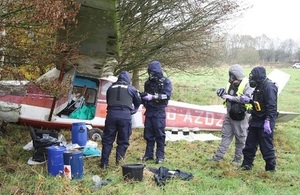Autonomy of Hazardous Scene Assessment Phase 2 – ‘MINERVA’
Winners announced in the latest round of the Autonomy of Hazardous Scene Assessment (AHSA) Defence and Security Accelerator competition which will change the way chemical and bio-hazards are investigated.

Image of plane crash that potentially contains hazardous substances
Part of the Government’s innovation initiative, the project is funded jointly by the Ministry of Defence science and technology portfolio and by the Home Office.
The overall competition is worth nearly £3 million over 18 months. Run through the Defence and Security Accelerator, working with the Defence Science and Technology Laboratory (Dstl), AHSA, to be known during phase 2 as ‘MINERVA’, is a competition to tackle the challenge of assessing scenes at incidents and on operations involving hazardous chemical or biological materials.
With a potential benefit to defence and security operations at home and abroad, the competition intends to help bring the conceptual designs into being, demonstration and eventual use, more quickly than usual.
Phase 1, which ran for 6 months until July 2017, funded 18 development projects and was worth £1.37million. Four of those initial phase 1 winners were then selected to develop their concepts further in this second phase. Early prototypes will be demonstrated by October 2018. Just over £1.6 million total funding was awarded to the following phase 2 winners:
- BMT Defence Services, with an unmanned aerial vehicle which has gas-sensing technology
- Horiba MIRA, which has a robot with its own neural networks which can deploy on decontamination missions
- Loughborough University, with a pocket-sized drone which can search for chemicals
- Snake Eyes, by Autonomous Devices Limited, which can be posted through a letter box and relay 3D images of a space and can detect chemical agents.
Peter Stockel, from Dstl, said: “After a fast-paced first phase, we are now delighted to rapidly move the project forward into phase 2 with four highly innovative and technically exciting system propositions to tackle this priority challenge for UK Defence and Security.
“With continued involvement and demonstration with the user community, we aim to mature this emergent capability over the next 12 months to test the ‘art of the possible’ and accelerate this into the hands of the prospective users for further operational evaluation, both for MOD and the Home Office.”
For more information visit AHSA or ‘MINERVA’.